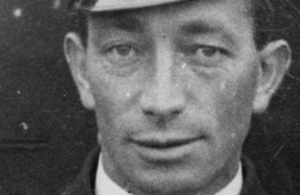WW1 New Zealand VC recipient William Edward Sanders
The story of New Zealand First World War Victoria Cross recipient William Edward Sanders.

Credit: © IWM (detail of HU 127787)
16 men from New Zealand received the Victoria Cross, Britain’s highest award for gallantry, during the First World War. As part of the Centenary Commemorations the people of the United Kingdom marked their gratitude to those courageous men by presenting a bronze memorial plaque to their home country engraved with their names. The plaque is now displayed in the grounds of the New Zealand Parliament, Wellington. This archive tells their stories.
Name: William Edward Sanders
DOB: 7 February 1883
Place of Birth: Auckland, New Zealand
Date of Action: 30 April 1917
Place of Action: At sea, south of Ireland
Rank: Lieutenant
Regiment: Royal Naval Reserve
William Sanders was born in Auckland, New Zealand, on 7 February 1883. He became a cabin boy on a steamer in 1899 and rose up through the ranks sailing on ships around New Zealand waters. At the outbreak of the First World War, he initially served in the Merchant Navy before moving to England and being commissioned a Sub-Lieutenant in the Royal Naval Reserve in April 1916. Sanders was promoted rapidly to Lieutenant and captained the HMS Prize, a “Q ship” which looked like an inoffensive sailing vessel but was heavily armed with hidden guns. Its task was to lure German submarines to the surface.
On 30 April 1917, about 180 miles south of Ireland, the HMS Prize saw off a German U-boat which had earlier attacked and badly damaged the ship. As the operation of Q ships was highly secret, the official announcement of Sanders’ Victoria Cross award in the London Gazette contained only 19 words:
However, after the war, a fuller account of the VC action was published:
HMS Prize a topsail schooner of 200 tons under the command of Lieutenant William Edward Sanders RNR, sighted an enemy submarine at three miles range and approaching slowly astern. The “panic party” in charge of Skipper William Henry Brewer RNR (Trawler Section), immediately abandoned ship. The ship’s head was put into the wind, and the gun crews concealed themselves lying face downwards on the deck. The enemy continued deliberately shelling the schooner, inflicting severe damage and wounding a number of men. For twenty minutes she continued to approach, firing as she came, but at length, apparently satisfied that no one remained on board she drew out of the schooner’s quarter 70 yards away. The White Ensign was hoisted immediately, the screens dropped, and all guns opened fire. A shell struck the foremost gun of the submarine, blowing it to atoms and annihilating the crew. Another shot demolished the conning tower, and at the same time a Lewis gun raked the survivors off the submarine’s deck. She sank four minutes after the commencement of the action in clouds of smoke, the glare of an internal fire being visible through the rents in her hull. The captain of the submarine, a warrant officer and one man were picked up and brought on board the Prize, which was then herself sinking fast. Captors and prisoners however succeeded in plugging the shot holes and keeping the water under pumps. The Prize set sail for land, 120 miles distant. They were finally picked up two days later by a motor launch and towed the remaining five miles into harbour.
Sanders was later promoted to Lieutenant Commander and was also awarded the Distinguished Service Order for another attack on a German submarine in June 1917. On 14 August 1917, the HMS Prize was blown up in a German torpedo attack. There were no survivors. There are several memorials to Sanders, including The Sanders Scholarship at the University of Auckland, and the Sanders Cup for yachts.